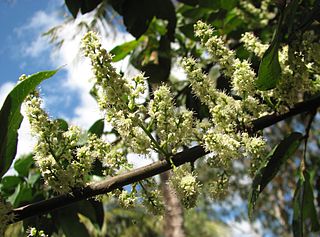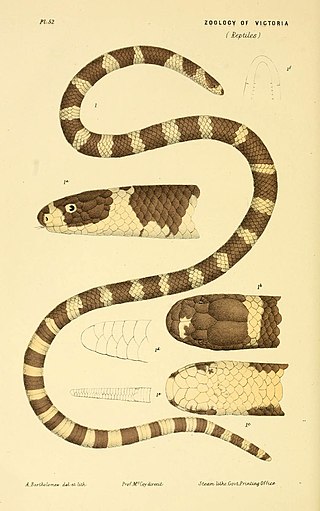A threatened species is any species which is vulnerable to extinction in the near future. Species that are threatened are sometimes characterised by the population dynamics measure of critical depensation, a mathematical measure of biomass related to population growth rate. This quantitative metric is one method of evaluating the degree of endangerment without direct reference to human activity.

Wobbegong is the common name given to the 12 species of carpet sharks in the family Orectolobidae. They are found in shallow temperate and tropical waters of the western Pacific Ocean and eastern Indian Ocean, chiefly around Australia and Indonesia, although one species occurs as far north as Japan. The word wobbegong is believed to come from an Australian Aboriginal language, meaning "shaggy beard", referring to the growths around the mouth of the shark of the western Pacific.

The dingiso, also known as the bondegezou or bakaga, is an endangered, long-tailed marsupial found only in mountain forests on the west of the island of New Guinea. It is a species of tree-kangaroo, which are mammals native to Australia and New Guinea that feed on leaves or other plant matter. It belongs to the macropodid family (Macropodidae) with kangaroos, and carries its young in a pouch like most other marsupials. Though sacred to the local Moni people, it is still threatened by hunting and habitat loss.
The conservation status of a group of organisms indicates whether the group still exists and how likely the group is to become extinct in the near future. Many factors are taken into account when assessing conservation status: not simply the number of individuals remaining, but the overall increase or decrease in the population over time, breeding success rates, and known threats. Various systems of conservation status are in use at international, multi-country, national and local levels, as well as for consumer use such as sustainable seafood advisory lists and certification. The two international systems are by the International Union for Conservation of Nature (IUCN) and The Convention on International Trade in Endangered Species of Wild Fauna and Flora (CITES).

Guioa is a genus of about 78 rainforest tree species known to science, which constitute part of the plant family Sapindaceae. They have a wide distribution, ranging from throughout Malesia, in Burma, Cambodia, Vietnam, Thailand, Malay Peninsula, Borneo, Sumatra, Philippines, Java, Flores, Timor, Sulawesi, Moluccas, New Guinea, further southwards through the east coast of Queensland and New South Wales, Australia and further eastwards to the Pacific Islands, including Tonga, New Caledonia, Fiji and Samoa.

The nail-tail wallabies, of genus Onychogalea, are three species of macropods, all found in Australia. Related to kangaroos and wallabies, they are smaller species distinguished by a horny spur at the end of their tail. The northern nail-tail wallaby is still common in the northern part of Australia, the crescent nail-tail is now extinct, and the bridled nail-tail is considered rare and endangered, with probably fewer than 1100 mature individuals in the wild. Nail-tail wallabies are smaller than many other wallabies.
The Lake Pedder planarian is a species of invertebrate in the family Dugesiidae.

The bandy-bandy, also commonly known as the hoop snake, is a species of venomous snake in the family Elapidae. The word bandy-bandy (bandi-bandi) traces back to the indigenous dialect of Kattang, from the Taree region, New South Wales. There are 5 known species of bandy-bandy, all of which are endemic to Australia.
This article lists the various snakes of Australia which live in a wide variety of habitats around the country. The Australian scrub python is Australia's largest native snake.

Vermicella is a genus of venomous snakes of the family Elapidae, commonly known as bandy-bandies or hoop snakes. The best known species is the bandy-bandy.

The Tasmanian long-eared bat is a species of vesper bat endemic to Tasmania.
Bachia trisanale, also known commonly as Stacy's bachia, is a species of lizard in the family Gymnophthalmidae. The species is endemic to South America. There are three recognized subspecies.
The intermediate bandy-bandy is a species of snake in the family Elapidae.
The Northern bandy bandy is a species of snake in the family Elapidae.
The Pilbara bandy bandy is a species of venomous snake in the family Elapidae. The species is endemic to Australia.
The Weipa bandy bandy is a species of snake in the family Elapidae, described in 2018.
Tantilla vermiformis, Hallowell's centipede snake, is a species of snake of the family Colubridae.








